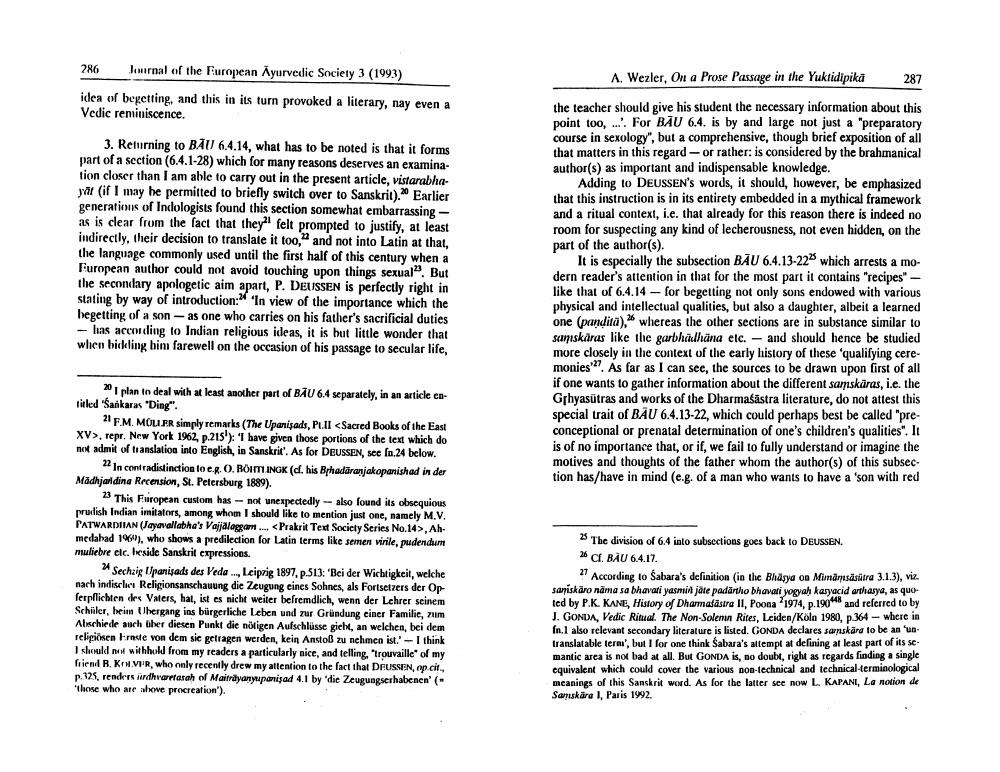________________
286
Journal of the Furopean Ayurvedic Society 3 (1993)
A. Wezler, On a Prose Passage in the Yuktidipika
287
idea of begetting, and this in its turn provoked a literary, nay even a Vedic reminiscence.
3. Returning to BAU 6.4.14, what has to be noted is that it forms part of a section (6.4.1-28) which for many reasons deserves an examination closer than I am able to carry out in the present article, vistarabhayvät (if I may he permitted to briefly switch over to Sanskrit). Earlier generations of Incologists found this section somewhat embarrassingas is clear from the fact that they felt prompted to justify, at least indirectly, their decision to translate it too, and not into Latin at that, the language commonly used until the first half of this century when a Furopean author could not avoid touching upon things sexual'. But the secondary apologetic aim apart, P. DEUSSEN is perfectly right in stating by way of introduction: 'In view of the importance which the hegetting of a son - as one who carries on his father's sacrificial duties - has according to Indian religious ideas, it is but little wonder that when bickling him farewell on the occasion of his passage to secular life,
the teacher should give his student the necessary information about this point too, ' For BĀU 6.4. is by and large not just a "preparatory course in sexology", but a comprehensive, though brief exposition of all that matters in this regard-or rather: is considered by the brahmanical author(s) as important and indispensable knowledge.
Adding to DEUSSEN's words, it should, however, be emphasized that this instruction is in its entirety embedded in a mythical framework and a ritual context, i.e. that already for this reason there is indeed no room for suspecting any kind of lecherousness, not even hidden, on the part of the author(s).
It is especially the subsection BAU 6.4.13-22° which arrests a modern reader's attention in that for the most part it contains "recipes" - like that of 6.4.14 - for begetting not only sons endowed with various physical and intellectual qualities, but also a daughter, albeit a learned one (pandita), whereas the other sections are in substance similar to suniskäras like the garbhadhana etc. - and should hence be studied more closely in the context of the early history of these 'qualifying ceremonies. As far as I can see, the sources to be drawn upon first of all if one wants to gather information about the different samskiras, i.e. the Ghyasutras and works of the Dharmaśāstra literature, do not attest this special trait of BAU 6.4.13-22, which could perhaps best be called "preconceptional or prenatal determination of one's children's qualities". It is of no importance that, or if, we fail to fully understand or imagine the motives and thoughts of the father whom the author(s) of this subsec. tion has/have in mind (e.g. of a man who wants to have a 'son with red
i plan to deal with at least another part of BÃU 6.4 separately, in an article en titled "Sankaras "Ding".
21 FM. MOUPR simply remarks (The Upanisads, Pull <Sacred Books of the East XV>, repr. New York 1962 p.215'): 1 have given those portions of the text which do not admit of translation into English, in Sanskrit'. As for DEUSSEN, sec (0.24 below.
In contradistinction toe. OROITTINGK (d. his Brhadaranjakopanishad in der Madhjaridina Recension, St. Petersburg 1889).
23 This Furopean custom has not unexpectedly also found its obsequious prulish Indian imitators, among whom I should like to mention just one, namely M.V. PATWARDIAN (Jayavallathe's Vajalopram.... <Prakrit Text Society Series No.14>, Ahmedabad 1999), who shows a predilection for Latin terms like semen vinile, pudendum muliebre elc. Beside Sanskrit expressions
Sechzig Ipanigads des Veda ..., Leipzig 1897, p.513: 'Bei der Wichtigkeit, welche nach indisclose Religionsanschauung die Zeugung eines Sohnes, als Fortsetzers der Op serpflichten des Vaters, hat, ist es nicht weiter befremdlich, wenn der Lehrer seinem Schüler, heim Uhergang ins bürgerliche Leben und zur Gründung einer Familie, zum Aluschiede auch über diesen Punkt die nötigen Aufschlüsse gicht, an welchen, bei dem religiösen Erste von dem sic getragen werden, kein Anstoß zu nehmen ist.'- I think I should not withhold from my readers a particularly nice, and telling, trouvaille" of my friend R. KW.VR, who only recently drew my attention to the fact that DFUSSEN, op cit, p. 125. renders indhverrarah of Maltrayanyupenisad 4.1 by 'die Zeugungserhabcncn' ( those who are above procreation').
3 The division of 6.4 into subsectious goes back to DEUSSEN. 26 . BAU 6.4.17.
11 According to Sabara's definition (in the Bhd.sya on Mindrisasitra 3.1.3), viz. samiskäro nama sa bhavari yasmidjate padartho bhavati yopah karyacid arthasya, as quoted by P.K. KANE, History of Dharmasastra II, Poona 1974, p.1905 and referred to by J. GONDA, Vedic Ritual. The Non-Solenn Rites, Lciden/Koln 1980, p.364 - where in In. I also relevant secondary literature is listed. GONDA declares sanskare to be an 'un translatable termi', but I for one think Sabara's attempt at defining at least part of its se mantic area is not bad at all. But GONDA is, so doubt, right as regards finding a single equivalent which could cover the various soo-technical and technical terminological meanings of this Sanskrit word. As for the latter see now L KAPANI, La notion de Samskära I, Paris 1992




